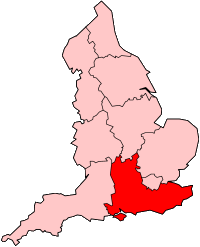Seaford branch line
| Seaford branch line | |
|---|---|
 Looking out toward Seaford from Newhaven Harbour | |
| Overview | |
| Type | Heavy rail |
| System | National Rail |
| Status | Operational |
| Locale |
East Sussex South East England |
| Termini |
Southerham Junction Seaford |
| Stations | 5 |
| Services |
Southerham Junction–Seaford Branch to Newhaven Marine (station closed) |
| Operation | |
| Opened | 1864 |
| Owner | Network Rail |
| Operator(s) | Southern |
| Character | Rural |
| Rolling stock |
Class 313 Class 377 "Electrostar" |
| Technical | |
| Line length | 7 miles 66 chains (12.59 km) |
| Number of tracks |
2 (Southerham Junction–Newhaven Harbour) 1 (Newhaven Harbour–Seaford) |
| Track gauge | 1,435 mm (4 ft 8 1⁄2 in) standard gauge |
| Electrification | 750 V DC Third Rail |
| Seaford branch line | |||||||||||||||||||||||||||||||||||||||||||||||||||||||||||||||||||||||||||||||||||
|---|---|---|---|---|---|---|---|---|---|---|---|---|---|---|---|---|---|---|---|---|---|---|---|---|---|---|---|---|---|---|---|---|---|---|---|---|---|---|---|---|---|---|---|---|---|---|---|---|---|---|---|---|---|---|---|---|---|---|---|---|---|---|---|---|---|---|---|---|---|---|---|---|---|---|---|---|---|---|---|---|---|---|---|
| |||||||||||||||||||||||||||||||||||||||||||||||||||||||||||||||||||||||||||||||||||
|
Mileage measured from London Bridge via Redhill | |||||||||||||||||||||||||||||||||||||||||||||||||||||||||||||||||||||||||||||||||||
The Seaford branch line is a rural railway line in East Sussex constructed in 1864 primarily to serve the port of Newhaven and the town of Seaford. It now sees fairly regular trains across the line except for the Newhaven Marine branch, which is still technically open but is fenced off from the public and not on any timetables.
History
Engineered by the London, Brighton and South Coast Railway's Chief Engineer Frederick Banister,[1] the first section of the line was opened in 1847 to aid the transport of goods to and from Newhaven. The line was extended in 1864 to serve the holiday town of Seaford. There used to be extensive sidings at Newhaven Docks and even a railway swing bridge over the River Ouse to connect to the other side. These have now been removed or have become overgrown, as has the defunct Newhaven Marine station, which has been fenced off from the public. Once a thriving station serving ferries to and from France, the walk of just under 1/4 mile to Newhaven Harbour station and the cessation of winter ferries forced its closure. The line was electrified (750 V DC third rail) by the Southern Railway in 1935. The line between Newhaven Harbour and Seaford was reduced to single track to save costs in 1975.
Route
- Services, generally originating from Brighton, stop at Lewes on the East Coastway Line, the last station before the branch line splits off.
- The branch line starts at Southerham Junction on the East Coastway Line
- The first station on the line is Southease, which serves the village of Southease and also has links to the South Downs Way
- The line then continues, running alongside the River Ouse to Newhaven Town, which is the station serving the town centre of Newhaven, across a swing bridge over the nearby river. Ferries to France are also a short walk from here.
- The following station Newhaven Harbour no longer serves ferries to France
- Immediately after Newhaven Harbour station, a small branch splits off to Newhaven Marine. Originally built to link with cross-channel ferries, this short branch line is now closed to passengers, but the track remains in situ.
- The line then becomes a single-track and is one of a few single-track third-rail lines in the country
- It passes the closed station of Bishopstone Beach Halt, and over a foot crossing that offers access to the abandoned village of Tide Mills.
- The line then straightens out and calls at two more stations
- Bishopstone (serving the village of Bishopstone and the western end of Seaford) and
- Seaford (the end of the line, serving Seaford town centre)
Train services
Train services are operated by Southern. Class 313s and Class 377 "Electrostars" are used on the line to transport passengers to Lewes, Brighton and London.
The normal off peak train service on the line is two trains per hour between Brighton and Seaford calling at London Road, Moulsecoomb, Falmer, Lewes and then all stations on the branch line.
Occasional peak hour services continue towards London Victoria via Haywards Heath, Gatwick Airport and East Croydon.
At off peak times, connections with services towards London can be made at Lewes.
Passenger volume
Comparing the number of passengers in year beginning April 2002 to the year beginning April 2010, Southease has increased by 96%, Newhaven Town by 45%, Bishopstone by 58% and Seaford by 56%. Newhaven Harbour has declined by 51%.[2]
| Station usage | ||||||||||||||
|---|---|---|---|---|---|---|---|---|---|---|---|---|---|---|
| Station name | 2002–03 | 2004–05 | 2005–06 | 2006–07 | 2007–08 | 2008–09 | 2009–10 | 2010–11 | 2011–12 | 2012–13 | 2013–14 | 2014–15 | 2015–16 | 2016–17 |
| Southease | 6,225 | 7,093 | 7,245 | 8,527 | 8,855 | 8,442 | 9,994 | 12,228 | ||||||
| Newhaven Town | 216,136 | 232,450 | 234,952 | 261,348 | 302,576 | 302,526 | 308,682 | 313,082 | ||||||
| Newhaven Harbour | 92,947 | 103,572 | 91,875 | 59,780 | 52,730 | 48,214 | 40,446 | 45,644 | ||||||
| Bishopstone | 19,282 | 17,128 | 18,099 | 24,041 | 27,542 | 28,784 | 29,632 | 30,432 | ||||||
| Seaford (East Sussex) | 493,247 | 596,021 | 630,624 | 697,956 | 769,510 | 797,008 | 765,776 | 769,870 | ||||||
| The annual passenger usage is based on sales of tickets in stated financial years from Office of Rail Regulation statistics. The statistics are for passengers arriving and departing from each station and cover twelve month periods that start in April. Please note that methodology may vary year on year. | ||||||||||||||
References
- ↑ "Federick Dale Banister". GracesGuide.co.uk. Retrieved 10 February 2013.
- ↑ "Station Usage". Rail Statistics. Office of Rail Regulation. Retrieved 7 January 2013.
